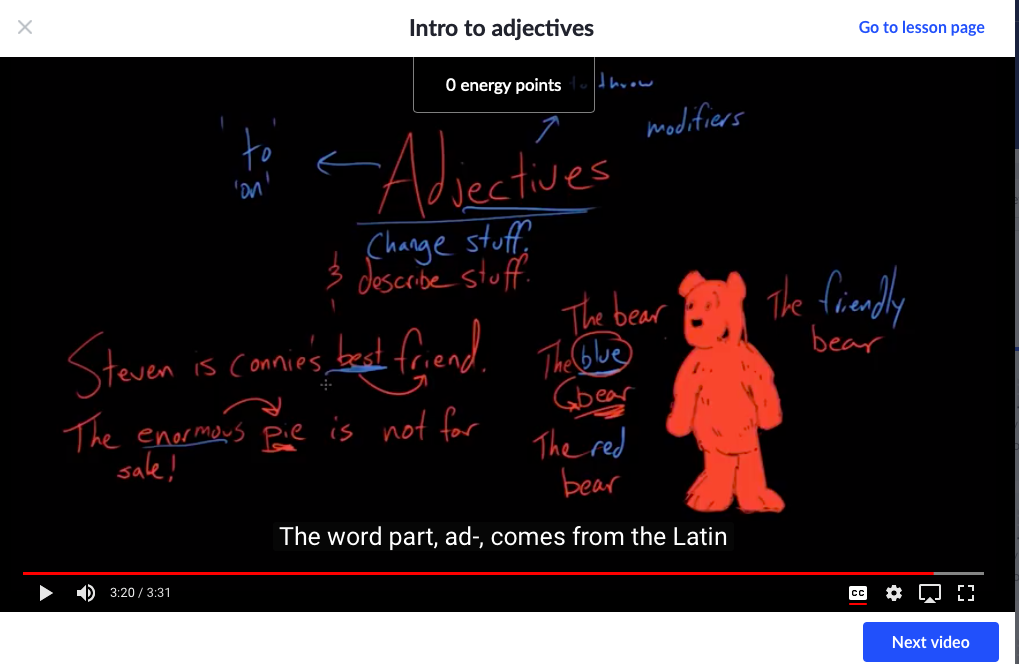I decided to take a closer look at Khan Academy, since under Arts and Humanities there is a Grammar course with six units, one of them on adjectives, the topic I chose for my blended course. I found the site quite easy to navigate and the lessons engaging.

The content covered in the unit entitled “The modifier” is well developed and detailed with clear explanation. The unit includes lessons on articles, adjectives and adverbs. As an English as an Additional Language (EAL) teacher, I would probably structure the unit a little differently, teaching the skills in smaller steps. Teaching the articles, adjectives and adverbs separately, before I compare and contrast adjectives and adverbs would help avoid any possible confusion. Pre-teaching might be necessary since I found the lessons be at a higher level. I would probably add more modules focusing on adjectives, their synonyms and antonyms, to help my students build vocabulary skills in order to express themselves easily.
The unit itself consists of engaging lessons representing the content through text, sound, still pictures and moving images. The text of the lessons is short and to the point. I particularly liked the teaching method chosen, giving the sensation of looking at a board, just like in a classroom. This is very helpful especially if we are teaching EAL students, since the learner can follow the lesson a lot easier when they hear it and see the information written down. This is a great tool to develop reading and listening skills at the same time. I also think that neat printing is crucial especially when teaching students who are new to the language. Incorporating typed up text can help avoid misunderstanding. The drawings and interesting stories make it easier for students to understand and remember the content covered, enabling them to use both eyes and ears in conjunction (Bates). The use of two different colours when explaining also helps in directing the listeners’ attention. The fact that the learners have the ability to stop and start the recorded audio, it enables them to master content, improve pronunciation, and listening skills. It also supports students with low literacy skills.

I liked that Khan Academy made the lessons more effective by including subtitles and transcript to every lesson. I think the auto-translate option is fantastic for the students with limited English level of proficiency, having the option to translate the subtitles for a better understanding. Listening to the Hungarian and Romanian translations, I found the accuracy level quite high. The added transcript makes the lessons accessible even to people with hearing disability.
The style of the lessons was quite catchy. I also found the length of the lessons very appropriate, ranging between 2-7 minutes, depending on the content covered. Every mini lesson is followed by a practice exercise where students can apply what they have comprehended. With the help of immediate feedback, students can easily reach mastery. The 16-20 minutes long unit test at the end assesses the ten skills covered by the unit. The detailed skill report provides the teacher with an accurate picture of the students’ understanding that is useful in order to support the students in the areas they are facing difficulties. The assessment is lacking in composed textual response though.
Although I found the modules effective and enjoyable, I think EAL students would benefit from short videos as well, that have a richer medium providing the opportunity to link the use of modifiers to our everyday lives. On the other hand, according to Bates, creating an audio clip has its advantages, requiring far less bandwidths than video, making the downloads quicker, and can be combined with text.
I think that Khan Academy’s freely available units can be very helpful for teachers who lack experience and/or time to develop high quality educational videos. The lessons can be posted directly into Google Classroom, Facebook, Twitter, and Email. There is also the option for teachers to create their own classroom of 24 students, with a ready to download parent permission form for students under 13. Unfortunately, the letter of permission is translated only into 9 languages. Having EAL families with limited English it would be beneficial to have the option to auto-translate the letter in various languages.

Thanks for the info! I agree about the time… I would love to make all my own instructional videos, and I have made some, but my own shortfalls with video editing, and my lack of time often leave me searching the internet for videos that are already finished. We have a large EAL population at our school, I will pass this along to their teachers!
Hi Brad,
Thank you for your comment! I agree, developing online lessons is very time consuming. Even searching the internet to find the right one takes up hours. I also think that if we can find ready-to-use lessons, there is no point creating new ones. We can always save our creativity for engaging follow-up activities and projects.
Thanks,
Melinda
I see a lot of good content on Khan Academy! I like the idea of someone else “teaching” the students and perhaps the words/phrases they choose will resonate more than the language I used. I like that they can be linked in with other platforms like you have listed. Good overview!
Hi Kyla,
Thank you so much for your kind words! I agree that there is good content on Khan Academy, as long as it meets our students’ needs and their level of English language proficiency. This can definitely make a big difference when we are prepping our blended or online courses.
Thanks,
Melinda 🙂
The Khan Academy has really evolved over the years and has branched out from the original math help it gave. Good points on visuals, colours, captions and more. The assessment piece now built in has really taken the academy to another level. Thanks for the post/review.
Thank you Dean! I appreciate all your help and support throughout the semester. You really helped me through some terribly tough times.
Take care,
Melinda
I love how useful this is for EAL students AND their families! I appreciate when you can translate material into other languages. Once they understand the content, they can focus on writing or speaking.
I agree, understanding the content is crucial.
Thanks,
Melinda
Great review of Khan Academy! As a math teacher, I am pretty familiar with some of the math units Khan has to offer but I have spent a limited amount of time researching the Humanities units! I love that it offers a grammar unit!! I also teach ELA and my grade twelve students are always struggling with appropriate uses of different types of speech! This would be a great “checker” for their understanding and allow them to work on skills they struggle with to become stronger writers. I think this is a great tool for EAL learners as you said and I appreciate your ideas, good and bad, for the content! I did not realize that Khan offered subtitles and transcripts in different languages which would be incredibly useful in a classroom full of different cultures! I like how critical you were of the resource and I too, agree that some of the sections could be modified to be smaller. If you were to apply it to your classroom, how would you assess their learning from the videos and exercises? Would you strictly use the assessments provided, create your own, or complete a mix of the two?
Hi Shelby,
Thank you so much for your kind words and positive thoughts. I do find the grammar lessons in Khan Academy at a very high level for my students. So I decided to start creating my own if I am unable to find the right one on Youtube. Since I teach grade 1-8 students, I feel that some of these lessons might be too long and confusing for them. For grade 12 students, depending on their English level of proficiency, they could be effective. To answer your questions regarding assessment, after assigning a certain area from Khan Academy, I would probably develop my own assignment to be used for both formative-, and summative assessment, incorporating the content covered in the classroom. This way they can connect the grammar concepts to the material learnt. I think the best way to assess correct use of grammar forms, is to ask students to produce something both orally and in writing. I have noticed my students using certain grammatical forms correctly when speaking but not in writing or vice versa.
Thank you and good luck!
Melinda 🙂
Hey Melinda!
I also did a review on Kahn Academy. I like how you referred to the screenshot as a blackboard. I never thought of it that way before and thought it was a little dull, but if I look at it as a blackboard, it makes it a bit better. I agree with you about chunking the lessons into smaller lessons. I though Kahn did a good job of providing basic lessons on the subject, but I wonder how engaged a grade 4 EAL student would be? Have you tried it out with your students yet?
Hi Kristina,
Thank you for your comment! I agree with you, I have seen more interesting and engaging lessons before. If I was to use the Khan Academy lessons, I would definitely have to chunk them up, adding a variety of follow-up activities to spice things up a little.
Thank you,
Melinda
Wonderful write-up! Very educational and effectively published. You protected The subject in good detail and offered fantastic illustrations to back up your points. This article will be a fantastic useful resource for those wanting To find out more concerning the matter. Thanks for the great work!